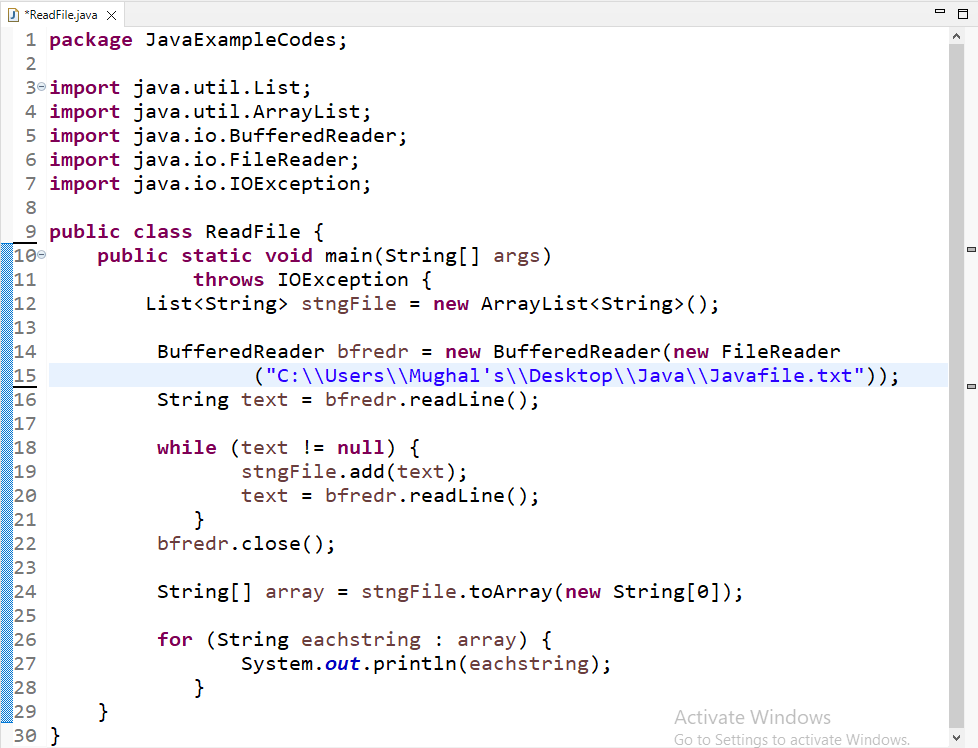This article will describe the methods to read a text file in Java and store it in an array.
How to Read a Text File and Store it in an Array?
There are four methods for reading the contents of a file, such as:
- The Scanner class
- The BufferedReader class
- The readAllLines() method
- The FileReader class
Note: For the demonstration purpose, first, we will create a text file named “Javafile.txt” that contains the following text:
LinuxHint
Now, we will discuss the most commonly used Java methods for the mentioned purpose.
Method 1: Read a Text File and Store it in an Array Using Scanner class
In Java, the “Scanner” class belongs to java.util package used to read data from users for primitive data types. It can also be used to read content from a file. To load content from a file, Scanner is used in combination with File or FileReader.
Let’s check out an example to understand the usage of Scanner for reading a text file and storing it in an array.
Example
In this example, first, we will create a String type ArrayList named “stngFile” to store the text content of a file:
Then, we will load the text of our “Javafile.txt” by creating a new object of Scanner class and pass the file path as an argument:
"C:\\Users\\Mughal's\\Desktop\\Java\\Javafile.txt"));
As a condition of the “while” loop, use “hasnext()” method to verify whether there are any strings left in the file or not. In its body, the created scanner object will read the file text and store it in the ArrayList “stngFile”:
while (scnr.hasNext()) {
str = scnr.next();
stngFile.add(str);
}
After getting all of all file text in ArrayList, convert it to array by using “toArray()” method:
Lastly, print the values stored in the array using the “for-each” loop:
System.out.println(eachString);
}
The given output indicates that we have successfully read a text file using Scanner class object and stored its content in an array:
Look at the below-given section to utilize BufferedReader class for reading a text file.
Method 2: Read a Text File and Store it in an Array Using BufferedReader Class
“BufferedReader” is another Java class used to read and load the file content in combination with the FileReader. Character files are read using the FileReader class. It performs a read operation on every character in the file. To read and load content from a file using the BufferedReader class is significantly faster as compared to other methods.
Example
First, we will create an object of the BufferedReader class by passing the file path to it:
("C:\\Users\\Mughal's\\Desktop\\Java\\Javafile.txt"));
The “bfredr” object will read a line from the specified file using “readLine()” method and store it in “text” String type variable:
Next, add a “while” loop that executes until the value of the “text” variable becomes “null”. Within the body, we will add the current value of the text variable to the “stngFile” ArrayList and update its value according to the next line’s content:
stngFile.add(text);
text = bfredr.readLine();
}
bfredr.close();
Then, convert the created ArrayList to an array by using the “toArray()” method:
Finally, we will print the text values stored in the array with the help of the “for-each” loop:
System.out.println(eachstring);
}
Output
We presented the information related to reading a text file and storing it in an array in Java.
Conclusion
To read a text file and store it in an array, Java provides many methods such as Scanner, BufferedReader, and FileReader classes and the readAllLines() method. However, Java programmers prefer Scanner and BufferReader classes because the BufferedReader object is faster, and the Scanner object is best for analyzing text data. In this article, we described the methods to read a text file and store it in an array in Java in detail.




